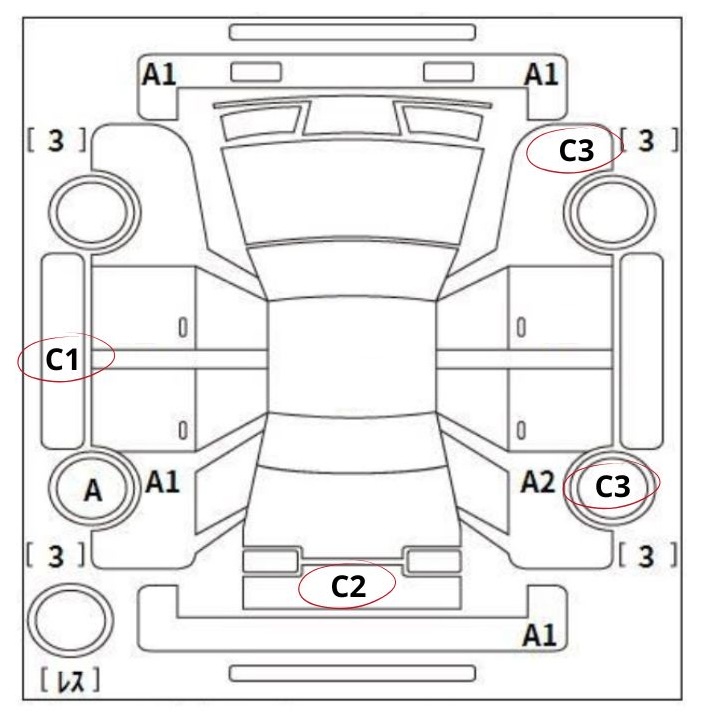Hello, future car experts! Have you ever seen a piece of old metal that looks brownish or has rough spots? That is called corrosion—a fancy word for rust or metal sickness. Just like people can catch a cold, cars can get corrosion too.
When Japanese car inspectors check a vehicle, they use special codes to describe how much corrosion it has. The codes C1, C2, and C3 tell us if the corrosion is a small problem or a big one. In this article, we will learn all about these codes in super simple words. Let’s get started!
What Is Corrosion?
Corrosion is what happens when metal meets water or air for a long time. It’s like when an apple turns brown after you bite it. For cars, corrosion can make the metal weak and full of holes.
Cars can get corrosion in different places:
- On the body (the outside part)
- Under the chassis (the bottom part)
- Near the wheels or doors
Inspectors use the codes C1, C2, and C3 to explain how bad the corrosion is.

C1 Corrosion: Slight Corrosion
C1 corrosion is like a small freckle on the car’s metal. It is just starting and does not look very serious.
- What it looks like: A small brown or orange spot. You might only see one or two of these spots.
- What it means: The metal is just beginning to get sick. It is not dangerous yet.
- What to do: It can be cleaned and treated easily. Think of it like putting a bandage on a tiny cut.
Remember: Many used cars have C1 corrosion. It is normal and not a big problem.
C2 Corrosion: Noticeable Corrosion
C2 corrosion is easier to see. It is like a rash on the car’s skin. The metal is more than just a little sick.
- What it looks like: Several brown or rough patches. You can see them without looking too hard.
- What it means: The corrosion is spreading. If not treated, it can become worse.
- What to do: It needs to be cleaned, treated, and maybe painted. This is like going to the doctor for medicine.
Important: A car with C2 corrosion might need some extra care and money to fix.
C3 Corrosion: Significant and Very Noticeable Corrosion
C3 corrosion is the most serious type. It is like a big wound on the car. The metal is very sick and might even have holes.
- What it looks like: Large, rough, and bumpy areas. The metal might be flaking or have holes.
- What it means: The corrosion has been there a long time. The metal is weak and might break easily.
- What to do: It needs a lot of work. Sometimes, parts must be cut out and replaced. This is like major surgery for the car.
Warning: Cars with C3 corrosion are often not safe to drive. They can be expensive to repair.
Why Should You Care About Corrosion?
Knowing about C1 C2 C3 corrosion helps you make smart choices when buying a car.
- Safety: Corrosion can make the car weak. In an accident, it might not protect you well.
- Money: Fixing corrosion can cost a lot. It’s better to know before you buy.
- Long Life: A car with no corrosion will last longer and be worth more.
How to Check for Corrosion
Even if you are not an expert, you can look for signs of corrosion:
- Look for Brown Spots: Check the car’s body, especially near the wheels and under the doors.
- Touch the Metal: If it feels rough or bumpy, it might have corrosion.
- Check Under the Car: Use a flashlight to look at the bottom.
If you are buying a car, always ask for the auction sheet. It will tell you if there is C1 C2 C3 corrosion.
What to Do If Your Car Has Corrosion
- C1: Clean the area and use a anti-rust treatment. It’s easy and cheap.
- C2: Take the car to a mechanic. They can treat it and repaint if needed.
- C3: Talk to a professional. It might be better to avoid buying the car.
Fun Facts About Corrosion
- 🚗 Cars in snowy places get more corrosion because of road salt.
- 🌧️ Cars near the ocean can get corrosion faster from salty air.
- 🔧 Regular washing helps prevent corrosion.
Final Thoughts
Now you understand C1 C2 C3 corrosion! Remember:
- C1 is a small problem—like a tiny cold.
- C2 is a bigger problem—like a bad cough.
- C3 is a very big problem—like a serious illness.
Always check the original auction sheet for these codes. If you need help, services like JP Sheets can explain the report in easy words.
Drive safe, and keep your car healthy!